Shikonin as a Dietary Phytochemical with Multi-Target Anti-Cancer Activities: From Molecular Mechanisms to Translational Applications
Abstract
1. Introduction
2. Chemistry and Pharmacokinetics
2.1. Methods of Isolation and Production of Shikonin
2.2. Shikonin Derivatives and Their Anticancer Activities
2.3. Pharmacokinetics of Shikonin and Its Pharmaceutical Formulations
3. Mechanisms of Anticancer Action
3.1. Induction of Apoptosis by Shikonin
3.1.1. Shikonin-Induced Intrinsic Apoptosis via MAPK Signalling and ROS-Mediated ER Stress
3.1.2. Extrinsic Apoptotic Pathways Triggered by Shikonin: Death Receptor and Caspase-8 Activation
3.1.3. Induction of Apoptosis Through Unique Signalling Pathways
3.1.4. Shikonin and Its Derivatives Induce Apoptosis in Drug-Resistant Cancer Cells
3.1.5. Apoptosis Effects of Shikonin Derivatives
3.2. Cell Cycle Arrest
3.3. Suppression of Metastasis and Invasion
3.4. Induction of Necroptosis
3.5. Induction of Ferroptosis
3.6. Induction of Pyroptosis
3.7. Inhibition of Tumour Metabolism
4. Combination Therapy
4.1. Shikonin as a Chemosensitiser: Enhancing Chemotherapy and Overcoming Resistance
4.1.1. Inhibition of PKM2 Expression in Non-Small Cell Lung Cancer
4.1.2. Upregulation of HMOX1-Induced Ferroptosis in Ovarian Cancer
4.1.3. Upregulation of p53-Mediated Apoptosis in Oesophageal Cancer
4.1.4. Inhibition of PAK1 Expression in Pancreatic Cancer
4.2. Endocrine-Targeted Therapy and Resistance Modulation by Shikonin
4.2.1. Activation of Mitochondrial-Mediated Apoptosis in Breast Cancer
4.2.2. Restoration of the uc.57–BCL11A Axis Overcomes Tamoxifen Resistance
4.3. Shikonin Enhances Immunotherapy via Immunogenic Cell Death
4.4. Shikonin Derivative β, β-Dimethylacrylshikonin Enhances Radiotherapy
5. Preclinical and Clinical Studies
6. Challenges and Future Perspectives
7. Conclusions
Author Contributions
Funding
Data Availability Statement
Acknowledgments
Conflicts of Interest
Abbreviations
| 1-κB⍺ | I kappaB alpha |
| 4-OHT | 4-hydroxytamoxifen |
| 5-FU | 5-fluorouracil |
| AMPK | AMP-activated protein kinase |
| APCs | Antigen-presenting cells |
| ATF4 | Activating transcription factor 4 |
| β-carotene | Beta-carotene |
| Bax | Bcl-2-associated X protein |
| Bcl | B-cell lymphoma |
| Bid | BH3-interacting domain death agonist |
| Ca2+ | Calcium |
| ccRCC | Clear cell renal cell carcinoma |
| CDK | Cyclin-dependent kinase |
| CHOP | C/EBP homologous protein |
| CML | Chronic myeloid leukaemia |
| CRC | Colorectal cancer |
| CRT | Calreticulin |
| CSCs | Cancer stem cells |
| CTL | Cytotoxic T lymphocytes |
| DAMPs | Damage-associated molecular patterns |
| DC | Dendritic cells |
| DISC | Death-inducing signalling complex |
| DNases | Deoxyribonucleases |
| DR | Death receptor |
| DX | Doxorubicin |
| EGFR | Epidermal growth factor receptor |
| EMT | Epithelial–mesenchymal transition |
| ER | Endoplasmic reticulum |
| ER+ | Oestrogen receptor–positive |
| ER− | Oestrogen receptor–negative |
| ERK | Extracellular signal-regulated kinase |
| ESCC | Oesophageal squamous cell carcinoma |
| ESM1 | Endothelial cell specific molecule 1 |
| FADD | Fas-associated death domain |
| FASL | Fas ligand |
| Fe2+ | Ferrous iron |
| FPE | First-pass effect |
| GC | Gastric cancer |
| GOT-1 | Glutamic-oxaloacetic transaminase 1 |
| GPER | G protein-coupled oestrogen receptor |
| GRP78 | Glucose-regulated protein 78 |
| GSDME | Gasdermin E |
| GTPBP4 | Guanosine triphosphate binding protein 4 |
| HCC | Hepatocellular carcinoma |
| HDAC | Histone deacetylase |
| HIF-1α | Hypoxia-inducible factor 1-alpha |
| HMOX1 | Heme oxygenase 1 |
| HNSCC | Head and neck squamous cell carcinomas |
| HPLC | High-performance liquid chromatography |
| HSCCC | High-speed counter-current chromatography |
| ICD | Immunogenic cell death |
| IHC | Immunohistochemistry |
| IR | Ionising radiation |
| IV | Intravenous |
| JNK | c-Jun N-terminal kinase |
| KM | Kunming |
| KRAS | Kirsten rat sarcoma virus |
| lncRNAs | Long non-coding RNAs |
| MAE | Microwave-assisted extraction |
| MAPK | Mitogen-activated protein kinase |
| MitoROS | Mitochondrial ROS |
| MLKL | Mixed lineage kinase domain-like protein |
| MM | Multiple myeloma |
| MMP | Mitochondrial membrane potential |
| MMP-2 | Matrix metalloproteinase-2 |
| MMP-9 | Matrix metalloproteinase-9 |
| MS | Murashige and Skoog |
| NF-κB | Nuclear factor kappa B |
| NHE1 | Sodium–hydrogen exchanger 1 |
| NSCLC | Non-small cell lung cancer |
| OSCC | Oral squamous cell carcinoma |
| OXA | Oxaliplatin |
| PAK1 | p21-activated kinase 1 |
| PAMPs | Pathogen-associated molecular patterns |
| PARP | Poly (ADP-ribose) polymerase |
| PBMC | Patient peripheral blood mononuclear cell |
| PCD | Programmed cell death |
| PDK1 | Pyruvate dehydrogenase kinase 1 |
| PFKFB2 | 6-phosphofruto-2-kinase/fructose-2,6-biphosphate |
| PHD3 | Prolyl hydroxylase 3 |
| PKM2 | Pyruvate kinase isoform M2 |
| PTEN | Phosphatase and tensin homologue |
| PUMA | p53 upregulated modulator of apoptosis |
| PYCR1 | Pyrroline-5-carboxylate reductase 1 |
| rhApo2L/TRAIL | Apo2 ligand/tumour necrosis factor-related apoptosis-inducing ligand |
| RIPK1 | Receptor-interacting protein kinase1 |
| RIPK3 | Receptor-interacting protein kinase3 |
| ROS | Reactive oxygen species |
| RT-PCR | Real-time polymerase chain reaction |
| SC-CO2 | Supercritical carbon dioxide |
| SCLC | Small cell lung cancer |
| SD | Sprague Dawley |
| STP | Sarcoma-targeting-peptide |
| TAM | Tamoxifen |
| TCM | Traditional Chinese Medicine |
| TGF-β | Transforming growth factor β |
| TIME | Tumour immune microenvironment |
| TLRs | Toll-like receptors |
| TME | Tumour microenvironment |
| TNBC | Triple negative breast cancer |
| TNFα | Tumour necrosis factor-α |
| TRAP1 | Tumour necrosis factor receptor-associated protein 1 |
| Tregs | Regulatory T Cells |
| TrxR1 | Thioredoxin reductase 1 |
| UAE | Ultrasonic-assisted extraction |
| XBP-1 | X-box binding protein 1 |
| Zn-SHK-PEG | Zinc-shikonin-polyethylene glycol |
References
- Bray, F.; Laversanne, M.; Sung, H.; Ferlay, J.; Siegel, R.L.; Soerjomataram, I.; Jemal, A. Global cancer statistics 2022: GLOBOCAN estimates of incidence and mortality worldwide for 36 cancers in 185 countries. CA Cancer J Clin. 2024, 74, 229–263. [Google Scholar] [CrossRef]
- Debela, D.T.; Muzazu, S.G.; Heraro, K.D.; Ndalama, M.T.; Mesele, B.W.; Haile, D.C.; Kitui, S.K.; Manyazewal, T. New approaches and procedures for cancer treatment: Current perspectives. SAGE Open Med. 2021, 9, 20503121211034366. [Google Scholar] [CrossRef]
- Khan, S.U.; Fatima, K.; Aisha, S.; Malik, F. Unveiling the mechanisms and challenges of cancer drug resistance. Cell Commun. Signal. 2024, 22, 109. [Google Scholar] [CrossRef] [PubMed]
- Katta, B.; Vijayakumar, C.; Dutta, S.; Dubashi, B.; Nelamangala Ramakrishnaiah, V.P. The incidence and severity of patient-reported side effects of chemotherapy in routine clinical care: A prospective observational study. Cureus 2023, 15, e38301. [Google Scholar] [CrossRef] [PubMed]
- Kennedy, L.B.; Salama, A.K.S. A review of cancer immunotherapy toxicity. CA Cancer J. Clin. 2020, 70, 86–104. [Google Scholar] [CrossRef]
- Rathee, S.; Patil, U.K.; Jain, S.K. Exploring the Potential of Dietary Phytochemicals in Cancer Prevention: A Comprehensive Review. J. Explor. Res. Pharmacol. 2024, 9, 34–47. [Google Scholar] [CrossRef]
- Kumar, A.; Nirmal, P.; Kumar, M.; Jose, A.; Tomer, V.; Oz, E.; Proestos, C.; Zeng, M.; Elobeid, T.; Sneha, K.; et al. Major Phytochemicals: Recent Advances in Health Benefits and Extraction Method. Molecules 2023, 28, 887. [Google Scholar] [CrossRef]
- Jaiswal, Y.; Liang, Z.; Zhao, Z. Botanical drugs in Ayurveda and Traditional Chinese Medicine. J. Ethnopharmacol. 2016, 194, 245–259. [Google Scholar] [CrossRef] [PubMed]
- Gupta, J.; Sharma, B.; Sorout, R.; Singh, R.G.; Ittishree Sharma, M.C. Ginger (Zingiber officinale) in traditional Chinese medicine: A comprehensive review of its anti-inflammatory properties and clinical applications. Pharmacol. Res. Mod. Chin. Med. 2025, 14, 100561. [Google Scholar] [CrossRef]
- Song, Y.; Ding, Q.; Hao, Y.; Cui, B.; Ding, C.; Gao, F. Pharmacological effects of shikonin and its potential in skin repair: A review. Molecules 2023, 28, 7950. [Google Scholar] [CrossRef]
- Hossain, M.S.; Wazed, M.A.; Asha, S.; Amin, M.R.; Shimul, I.M. Dietary phytochemicals in health and disease: Mechanisms, clinical evidence, and applications: A comprehensive review. Food Sci. Nutr. 2025, 13, e70101. [Google Scholar] [CrossRef]
- Gezer, A.; Üstündağ, H.; Özkaraca, M.; Sari, E.K.; Gür, C. Therapeutic effects of resveratrol and β-carotene on L-arginine-induced acute pancreatitis through oxidative stress and inflammatory pathways in rats. Sci Rep. 2024, 14, 32068. [Google Scholar] [CrossRef] [PubMed]
- Malik, S.; Brudzyńska, P.; Khan, M.R.; Sytar, O.; Makhzoum, A.; Sionkowska, A. Natural plant-derived compounds in food and cosmetics: A paradigm of shikonin and its derivatives. Materials 2023, 16, 4377. [Google Scholar] [CrossRef] [PubMed]
- Andújar, I.; Ríos, J.L.; Giner, R.M.; Recio, M.C. Pharmacological properties of shikonin: A review of literature since 2002. Planta Med. 2013, 79, 1685–1697. [Google Scholar] [CrossRef] [PubMed]
- Gautam, S.; Lapčík, L.; Lapčíková, B. Pharmacological significance of Boraginaceae with special insights into shikonin and its potential in the food industry. Foods 2024, 13, 1350. [Google Scholar] [CrossRef]
- Barkizatova, G.; Turgumbayeva, A.; Zhakipbekov, K.; Bekesheva, K.; Arystanov, Z.; Arystanova, T.; Kayupova, F.; Zhumalina, K.; Toxanbayeva, Z.; Ibragimova, A.; et al. Exploring the pharmacological potential of Lithospermum officinale L.: A review of phytochemicals and ethnomedicinal uses. Molecules 2024, 29, 1856. [Google Scholar] [CrossRef]
- Pandey, P.; Lakhanpal, S.; Jamuna, K.V.; Singh, A.; Abohassan, M.; Park, M.N.; Shin, S.W.; Kang, H.N.; Zahera, M.; Saeed, M.; et al. Review projecting shikonin as a therapeutic candidate in female carcinomas: A preclinical perspective. Front. Pharmacol. 2025, 16, 1627124. [Google Scholar] [CrossRef]
- Yan, C.; Li, Q.; Sun, Q.; Yang, L.; Liu, X.; Zhao, Y.; Shi, M.; Li, X.; Luo, K. Promising nanomedicines of shikonin for cancer therapy. Int. J. Nanomed. 2023, 18, 1195–1218. [Google Scholar] [CrossRef]
- Yazaki, K. Lithospermum erythrorhizon cell cultures: Present and future aspects. Plant Biotechnol. 2017, 34, 131–142. [Google Scholar] [CrossRef] [PubMed]
- Huang, X.Y.; Fu, H.L.; Tang, H.Q.; Yin, Z.Q.; Zhang, W.; Shu, G.; Yin, L.Z.; Zhao, L.; Yan, X.R.; Lin, J.C. Optimization extraction of shikonin using ultrasound-assisted response surface methodology and antibacterial studies. Evid Based Complement Altern. Med. 2020, 2020, 1208617. [Google Scholar] [CrossRef]
- Leote, R.J.B.; Sanz, C.G.; Diculescu, V.C. Electrochemical characterization of shikonin and in-situ evaluation of interaction with DNA. J. Electroanal. Chem. 2022, 921, 116663. [Google Scholar] [CrossRef]
- Qi, K.; Li, J.; Hu, Y.; Qiao, Y.; Mu, Y. Research progress in mechanism of anticancer action of shikonin targeting reactive oxygen species. Front. Pharmacol. 2024, 15, 1416781. [Google Scholar] [CrossRef] [PubMed]
- Sagratini, G.; Cristalli, G.; Giardinà, D.; Gioventù, G.; Maggi, F.; Ricciutelli, M.; Vittori, S. Alkannin/shikonin mixture from roots of Onosma echioides (L.) L.: Extraction method study and quantification. J. Sep. Sci. 2008, 31, 945–952. [Google Scholar] [CrossRef]
- Azuma, H.; Li, J.; Youda, R.; Suzuki, T.; Miyamoto, K.; Taniguchi, T.; Nagasaki, T. Improved isolation procedure for shikonin from the root of the Chinese medicinal plant Lithospermum erythrorhizon and its solubilization with cyclodextrins. J. Appl. Res. Med. Aromat Plants 2016, 3, 58–63. [Google Scholar] [CrossRef]
- Gheisary, B.; Fattahi, M.; Alipour, H. Enhancing extraction of shikonin and phenolic antioxidants from Echium italicum L. using ultrasound and response surface methodology: Optimizing temperature, time, and liquid–solid ratio. Biomass Convers Biorefinery 2025, 15, 15619–15630. [Google Scholar] [CrossRef]
- Shen, L.; Pang, S.; Zhong, M.; Sun, Y.; Qayum, A.; Liu, Y.; Rashid, A.; Xu, B.; Liang, Q.; Ma, H.; et al. A comprehensive review of ultrasonic assisted extraction (UAE) for bioactive components: Principles, advantages, equipment, and combined technologies. Ultrason. Sonochem. 2023, 101, 106646. [Google Scholar] [CrossRef]
- MS, U.; Ferdosh, S.; Haque Akanda, M.J.; Ghafoor, K.; AH, R.; Ali, M.E.; Kamaruzzaman, B.Y.; MB, F.; Hadiaj, S.; Shaarani, S.; et al. Techniques for the extraction of phytosterols and their benefits in human health: A review. Sep. Sci. Technol. 2018, 53, 2206–2223. [Google Scholar] [CrossRef]
- Gao, S.; You, J.; Wang, Y.; Zhang, R.; Zhang, H. On-line continuous sampling dynamic microwave-assisted extraction coupled with high performance liquid chromatographic separation for the determination of lignans in Wuweizi and naphthoquinones in Zicao. J. Chromatogr. B. 2012, 887–888, 35–42. [Google Scholar] [CrossRef]
- Uwineza, P.A.; Waśkiewicz, A. Recent advances in supercritical fluid extraction of natural bioactive compounds from natural plant materials. Molecules 2020, 25, 3847. [Google Scholar] [CrossRef]
- Shen, J.; Shen, W.; Cai, X.; Wang, J.; Zheng, M. High performance liquid chromatographic method for deter-mination of active components in lithospermum oil and its application to process optimization of litho-spermum oil prepared by supercritical fluid extraction. Se Pu. 2021, 39, 708–714. (In Chinese) [Google Scholar] [CrossRef]
- Liu, T.; Ma, C.; Yang, L.; Wang, W.; Sui, X.; Zhao, C.; Zu, Y. Optimization of shikonin homogenate extraction from Arnebia euchroma using response surface methodology. Molecules 2013, 18, 466–481. [Google Scholar] [CrossRef]
- Akgun, I.H.; Erkucuk, A.; Pilavtepe, M.; Yesil-Celiktas, O. Optimization of total alkannin yields of Alkanna tinctoria by using sub- and supercritical carbon dioxide extraction. J. Supercrit. Fluids 2011, 57, 31–37. [Google Scholar] [CrossRef]
- Assimopoulou, A.N.; Sturm, S.; Stuppner, H.; Papageorgiou, V.P. Preparative isolation and purification of alkannin/shikonin derivatives from natural products by high-speed counter-current chromatography. Biomed. Chromatogr. BMC 2009, 23, 182–198. [Google Scholar] [CrossRef]
- Bagheri, F.; Tahvilian, R.; Karimi, N.; Chalabi, M.; Azami, M. Shikonin production by callus culture of Onosma bulbotrichom as active pharmaceutical ingredient. Iran J. Pharm. Res. 2018, 17, 495–504. [Google Scholar]
- Yazaki, K.; Tanaka, S.; Matsuoka, H.; Sato, F. Stable transformation of Lithospermum erythrorhizon by Agrobacterium rhizogenes and shikonin production of the transformants. Plant Cell Rep. 1998, 18, 214–219. [Google Scholar] [CrossRef] [PubMed]
- Yadav, S.; Sharma, A.; Nayik, G.A.; Cooper, R.; Bhardwaj, G.; Sohal, H.S.; Mutreja, V.; Kaur, R.; Areche, F.O.; AlOudat, M.; et al. Review of Shikonin and Derivatives: Isolation, Chemistry, Biosynthesis, Pharmacology and Toxicology. Front. Pharmacol. 2022, 13, 905755. [Google Scholar] [CrossRef] [PubMed]
- Wang, F.; Yao, X.; Zhang, Y.; Tang, J. Synthesis, biological function and evaluation of Shikonin in cancer therapy. Fitoterapia 2019, 134, 329–339. [Google Scholar] [CrossRef]
- Wang, R.; Guo, H.; Cui, J.; Li, S. A novel and efficient total synthesis of shikonin. Tetrahedron Lett. 2012, 53, 3977–3980. [Google Scholar] [CrossRef]
- Zhou, W.; Peng, Y.; Li, S.S. Semi-synthesis and anti-tumor activity of 5,8-O-dimethyl acylshikonin derivatives. Eur. J. Med. Chem. 2010, 45, 6005–6011. [Google Scholar] [CrossRef]
- Huang, G.; Zhao, H.R.; Meng, Q.Q.; Zhang, Q.J.; Dong, J.Y.; Zhu, B.Q.; Li, S.S. Synthesis and biological evaluation of sulfur-containing shikonin oxime derivatives as potential antineoplastic agents. Eur. J. Med. Chem. 2018, 143, 166–181. [Google Scholar] [CrossRef]
- Bhat, A.M.; Bhat, I.A.; Abdullah, S.T. Melanogenesis inhibition by (2-methylbutyryl) shikonin, a naturally occurring naphthoquinone, potentiates dacarbazine anti-melanoma efficacy via ROS-mediated apoptotic pathway. Pharmacol. Res. Mod. Chin. Med. 2025, 16, 100651. [Google Scholar] [CrossRef]
- Todorovic, Z.; Milovanovic, J.; Arsenijevic, D.; Vukovic, N.; Vukic, M.; Arsenijevic, A.; Djurdjevic, P.; Milovanovic, M.; Arsenijevic, N. Shikonin Derivatives from Onsoma visianii Decrease Expression of Phosphorylated STAT3 in Leukemia Cells and Exert Antitumor Activity. Nutrients 2021, 13, 1147. [Google Scholar] [CrossRef]
- Fan, Y.; Jin, S.; He, J.; Shao, Z.; Yan, J.; Feng, T.; Li, H. Effect of β,β-Dimethylacrylshikonin on Inhibition of Human Colorectal Cancer Cell Growth In Vitro and In Vivo. Int. J. Mol. Sci. 2012, 13, 9184–9198. [Google Scholar] [CrossRef] [PubMed]
- Shen, Z.J.; Zhang, Y.Y.; Feng, Y.Y.; Ji, S.J.; Yu, J.; Zhou, X.W.; Chen, J.; Xu, Y.; Zhang, L.M. β,β-Dimethylacrylshikonin exerts antitumor activity via Notch-1 signaling pathway in vitro and in vivo. Biochem. Pharmacol. 2012, 84, 507–512. [Google Scholar] [CrossRef]
- Hasenoehrl, C.; Schwach, G.; Ghaffari-Tabrizi-Wizsy, N.; Fuchs, R.; Kretschmer, N.; Bauer, R.; Pfragner, R. Anti-tumor effects of shikonin derivatives on human medullary thyroid carcinoma cells. Endocr. Connect. 2017, 6, 53–62. [Google Scholar] [CrossRef]
- Shao, K.Y.; Luo, S.D.; Huang, E.Y.; Chang, T.M.; Botcha, L.; Sehar, M.; Liu, J.F.; Chuang, P.K. Acetylshikonin induces cell necroptosis via mediating mitochondrial function and oxidative stress-regulated signaling in human Oral Cancer cells. Bioorganic Chem. 2025, 159, 108396. [Google Scholar] [CrossRef]
- Tang, Y.; Wang, Y.; Wang, X.; Zhao, Z.; Cai, H.; Xie, M.; Jiang, X.; Zhang, L.; Cheng, J.; Yang, L.; et al. Acetylshikonin exerts anti-tumor effects on non-small cell lung cancer through dual inhibition of STAT3 and EGFR. Phytomedicine 2022, 101, 154109. [Google Scholar] [CrossRef] [PubMed]
- Lin, H.; Ma, X.; Yang, X.; Chen, Q.; Wen, Z.; Yang, M.; Fu, J.; Yin, T.; Lu, G.; Qi, J.; et al. Natural shikonin and acetyl-shikonin improve intestinal microbial and protein composition to alleviate colitis-associated colorectal cancer. Int. Immunopharmacol. 2022, 111, 109097. [Google Scholar] [CrossRef] [PubMed]
- Zeng, Y.; Zhang, H.; Zhu, M.; Pu, Q.; Li, J.; Hu, X. β-Hydroxyisovaleryl-Shikonin Exerts an Antitumor Effect on Pancreatic Cancer Through the PI3K/AKT Signaling Pathway. Front. Oncol. 2022, 12, 904258. [Google Scholar] [CrossRef]
- Lu, D.; Qian, J.; Li, W.; Feng, Q.; Pan, S.; Zhang, S. β-hydroxyisovaleryl-shikonin induces human cervical cancer cell apoptosis via PI3K/AKT/mTOR signaling. Oncol. Lett. 2015, 10, 3434–3442. [Google Scholar] [CrossRef]
- Lee, C.Y.; Chen, P.N.; Kao, S.H.; Wu, H.H.; Hsiao, Y.H.; Huang, T.Y.; Wang, P.H.; Yang, S.F. Deoxyshikonin triggers apoptosis in cervical cancer cells through p38 MAPK-mediated caspase activation. Environ. Toxicol. 2024, 39, 4308–4317. [Google Scholar] [CrossRef]
- Park, D.G.; Kim, D.J.; Woo, B.H.; Kim, H.J.; Choi, Y.W.; Park, H.R. Isobutyrylshikonin has a potentially stronger cytotoxic effect in oral cancer cells than its analogue shikonin in vitro. Arch. Oral. Biol. 2020, 116, 104774. [Google Scholar] [CrossRef]
- Li, M.; Chen, X.; Hu, S.; Wang, R.; Peng, X.; Bai, X. Determination of blood concentrations of main active compounds in Zi-Cao-Cheng-Qi decoction and their total plasma protein binding rates based on hollow fiber liquid phase microextraction coupled with high performance liquid chromatography. J. Chromatogr. B 2018, 1072, 355–361. [Google Scholar] [CrossRef]
- Shao, Y.Y.; Yin, Y.; Lian, B.P.; Leng, J.F.; Xia, Y.Z.; Kong, L.Y. Synthesis and biological evaluation of novel shikonin-benzo[b]furan derivatives as tubulin polymerization inhibitors targeting the colchicine binding site. Eur. J. Med. Chem. 2020, 190, 112105. [Google Scholar] [CrossRef]
- Iranzadeh, S.; Dalil, D.; Kohansal, S.; Isakhani, M. Shikonin in breast cancer treatment: A comprehensive review of molecular pathways and innovative strategies. J. Pharm. Pharmacol. 2024, 76, 967–982. [Google Scholar] [CrossRef]
- Huang, C.S.; Chen, H.W.; Lin, T.Y.; Lin, A.H.; Lii, C.K. Shikonin upregulates the expression of drug-metabolizing enzymes and drug transporters in primary rat hepatocytes. J. Ethnopharmacol. 2018, 216, 18–25. [Google Scholar] [CrossRef] [PubMed]
- Li, H.; Luo, S.; Zhou, T. Studies on in vitro metabolism of shikonin. Phytother. Res. 1999, 13, 236–238. [Google Scholar] [CrossRef]
- Liu, P.; Chen, G.; Zhang, J. A Review of Liposomes as a Drug Delivery System: Current Status of Approved Products, Regulatory Environments, and Future Perspectives. Molecules 2022, 27, 1372. [Google Scholar] [CrossRef] [PubMed]
- Wen, X.; Li, J.; Cai, D.; Yue, L.; Wang, Q.; Zhou, L.; Fan, L.; Sun, J.; Wu, Y. Anticancer Efficacy of Targeted Shikonin Liposomes Modified with RGD in Breast Cancer Cells. Molecules 2018, 23, 268. [Google Scholar] [CrossRef] [PubMed]
- Guo, J.; Miao, Y.; Nie, F.; Gao, F.; Li, H.; Wang, Y.; Liu, Q.; Zhang, T.; Yang, X.; Liu, L.; et al. Zn-Shik-PEG nanoparticles alleviate inflammation and multi-organ damage in sepsis. J. Nanobiotechnology 2023, 21, 448. [Google Scholar] [CrossRef]
- Soni, K.S.; Desale, S.S.; Bronich, T.K. Nanogels: An overview of properties, biomedical applications and obstacles to clinical translation. J. Control Release 2016, 240, 109–126. [Google Scholar] [CrossRef]
- Li, S.; Zhang, T.; Xu, W.; Ding, J.; Yin, F.; Xu, J.; Sun, W.; Wang, H.; Sun, M.; Cai, Z.; et al. Sarcoma-Targeting Peptide-Decorated Polypeptide Nanogel Intracellularly Delivers Shikonin for Upregulated Osteosarcoma Necroptosis and Diminished Pulmonary Metastasis. Theranostics 2018, 8, 1361–1375. [Google Scholar] [CrossRef] [PubMed]
- Los, M.; Mozoluk, M.; Ferrari, D.; Stepczynska, A.; Stroh, C.; Renz, A.; Herceg, Z.; Wang, Z.Q.; Schulze-Osthoff, K. Activation and caspase-mediated inhibition of PARP: A molecular switch between fibroblast necrosis and apoptosis in death receptor signaling. Mol. Biol. Cell. 2002, 13, 978–988. [Google Scholar] [CrossRef] [PubMed]
- Kim, J.W.; Kim, K.; Kang, K.; Joe, C.O. Inhibition of homodimerization of poly(ADP-ribose) polymerase by its C-terminal cleavage products produced during apoptosis. J. Biol. Chem. 2000, 275, 8121–8125. [Google Scholar] [CrossRef]
- Chaitanya, G.V.; Alexander, J.S.; Babu, P.P. PARP-1 cleavage fragments: Signatures of cell-death proteases in neurodegeneration. Cell Commun. Signal 2010, 8, 31. [Google Scholar] [CrossRef]
- Alam, M.M.; Kariya, R.; Boonnate, P.; Kawaguchi, A.; Okada, S. Induction of apoptosis by shikonin through ROS-mediated intrinsic and extrinsic apoptotic pathways in primary effusion lymphoma. Transl. Oncol. 2021, 14, 101006. [Google Scholar] [CrossRef]
- Shilnikova, K.; Piao, M.J.; Kang, K.A.; Fernando, P.D.S.M.; Herath, H.M.U.L.; Cho, S.J.; Hyun, J.W. Natural compound shikonin induces apoptosis and attenuates epithelial-to-mesenchymal transition in radiation-resistant human colon cancer cells. Biomol. Ther. 2022, 30, 137–144. [Google Scholar] [CrossRef]
- Lohberger, B.; Glänzer, D.; Kaltenegger, H.; Eck, N.; Leithner, A.; Bauer, R.; Kreutz, D. Shikonin derivatives cause apoptosis and cell cycle arrest in human chondrosarcoma cells via death receptors and MAPK regulation. BMC Cancer 2022, 22, 758. [Google Scholar] [CrossRef]
- Tsai, M.F.; Chen, S.M.; Ong, A.Z.; Chung, Y.H.; Chen, P.N.; Hsieh, Y.H.; Hsieh, Y.S. Shikonin induced programmed cell death through generation of reactive oxygen species in renal cancer cells. Antioxidants 2021, 10, 1831. [Google Scholar] [CrossRef] [PubMed]
- Boonnate, P.; Kariya, R.; Okada, S. Shikonin induces ROS-dependent apoptosis via mitochondria depolarization and ER stress in adult T cell leukemia/lymphoma. Antioxidants 2023, 12, 864. [Google Scholar] [CrossRef]
- Lee, J.H.; Han, S.H.; Kim, Y.M.; Kim, S.H.; Yoo, E.S.; Woo, J.S.; Kim, H.J.; Baek, N.I.; Lee, S.H.; Lee, C.W.; et al. Shikonin inhibits proliferation of melanoma cells by MAPK pathway-mediated induction of apoptosis. Biosci. Rep. 2021, 41, BSR20203834. [Google Scholar] [CrossRef]
- Dwivedi, P. ROS mediated apoptotic pathways in primary effusion lymphoma: Comment on induction of apoptosis by shikonin through ROS-mediated intrinsic and extrinsic pathways in primary effusion lymphoma. Transl. Oncol. 2021, 14, 101061. [Google Scholar] [CrossRef]
- Zhang, N.; Peng, F.; Wang, Y.; Yang, L.; Wu, F.; Wang, X.; Ye, C.; Han, B.; He, G. Shikonin induces colorectal carcinoma cell apoptosis and autophagy by targeting galectin-1/JNK signaling axis. Int. J. Biol. Sci. 2020, 16, 147–161. [Google Scholar] [CrossRef]
- Király, J.; Szabó, E.; Fodor, P.; Fejes, Z.; Nagy, B.; Juhász, É.; Földesi, I.; Gubán, B.; Jóna, Á.; Póka, R.; et al. Shikonin causes an apoptotic effect on human kidney cancer cells through Ras/MAPK and PI3K/AKT pathways. Molecules 2023, 28, 6725. [Google Scholar] [CrossRef] [PubMed]
- Wang, F.; Mayca Pozo, F.; Tian, D.; Geng, X.; Yao, X.; Zhang, Y.; Guo, M. Shikonin inhibits cancer through p21 upregulation and apoptosis induction. Front. Pharmacol. 2020, 11, 861. [Google Scholar] [CrossRef]
- Qi, H.; Zhang, X.; Liu, H.; Han, M.; Tang, X.; Qu, S.; Li, S.; Li, J.; Song, G.; Li, B. Shikonin induced apoptosis mediated by endoplasmic reticulum stress in colorectal cancer cells. J. Cancer 2022, 13, 243–252. [Google Scholar] [CrossRef] [PubMed]
- Shan, Z.L.; Zhong, L.; Xiao, C.L.; Gan, L.G.; Xu, T.; Song, H.; Zhou, J.; Chen, J.; Liu, B.; Xu, J. Shikonin suppresses proliferation and induces apoptosis in human leukemia NB4 cells through modulation of MAPKs and c-Myc. Mol. Med. Rep. 2017, 16, 3055–3060. [Google Scholar] [CrossRef] [PubMed]
- Ma, X.; Yu, M.; Hao, C.; Yang, W. Shikonin induces tumor apoptosis in glioma cells via endoplasmic reticulum stress, and Bax/Bak mediated mitochondrial outer membrane permeability. J. Ethnopharmacol. 2020, 263, 113059. [Google Scholar] [CrossRef]
- Zhang, J.; Guo, J.; Gu, B.; Wang, F.; Li, Y.; Shang, L.; Sun, S.; Zhao, Y.; Zhao, Z. Shikonin induces autophagy and apoptosis in esophageal cancer EC9706 cells by regulating the AMPK/mTOR/ULK axis. Anal. Cell Pathol. 2024, 2024, 7752299. [Google Scholar] [CrossRef]
- Ashkenazi, A. Targeting the extrinsic apoptotic pathway in cancer: Lessons learned and future directions. J. Clin. Invest. 2015, 125, 487–489. [Google Scholar] [CrossRef]
- Ashkenazi, A. Targeting the extrinsic apoptosis pathway in cancer. Cytokine Growth Factor Rev. 2008, 19, 325–331. [Google Scholar] [CrossRef]
- Liu, C.; Xuan, L.Q.; Li, K.; Feng, Z.; Lv, C.; Li, X.J.; Zhang, J.; Zhao, Z.; Wu, Q. Shikonin inhibits cholangiocarcinoma cell line QBC939 by regulating apoptosis, proliferation, and invasion. Cell Transplant. 2021, 30, 0963689720979162. [Google Scholar] [CrossRef]
- Chang, Y.H.; Lin, Y.J.; Huang, C.Y.; Harnod, T.; Ding, D.C. Shikonin impedes type 2 ovarian cancer progression via FasL/caspase-8 and miR-874-3p/XIAP axis and prohibits the properties of stemness. Am. J. Cancer Res. 2022, 12, 4584–4601. [Google Scholar] [PubMed]
- Zhang, J.; Shang, L.; Jiang, W.; Wu, W. Shikonin induces apoptosis and autophagy via downregulation of pyrroline-5-carboxylate reductase 1 in hepatocellular carcinoma cells. Bioengineered 2022, 13, 7904–7918. [Google Scholar] [CrossRef] [PubMed]
- Wang, H.; Liu, Z.; Li, X.; Zhao, R.; Pu, Y.; Wu, H.; Liu, J.; Wang, F. Shikonin causes apoptosis by disrupting intracellular calcium homeostasis and mitochondrial function in human hepatoma cells. Exp. Ther. Med. 2018, 15, 1484–1492. [Google Scholar] [CrossRef]
- Zhang, H.; Chen, Z.; Zhao, X.; Huo, Q.; Cheng, X. Shikonin induces hepatocellular carcinoma cell apoptosis by suppressing PKM2/PHD3/HIF-1α signaling pathway. Nan Fang Yi Ke Da Xue Xue Bao 2023, 43, 92–98. [Google Scholar] [CrossRef] [PubMed]
- Huang, J.; Zhao, L.; Gong, C.; Wang, Y.; Qu, Y.; Ji, C.; Zhang, H.; Wang, J. Shikonin promotes apoptosis and attenuates migration and invasion of human esophageal cancer cells by inhibiting tumor necrosis factor receptor-associated protein 1 expression and AKT/mTOR signaling pathway. Evid. Based Complement Alternat. Med. 2021, 2021, 5386050. [Google Scholar] [CrossRef] [PubMed]
- Pan, J.; Li, M.; Yu, F.; Zhu, F.; Wang, L.; Ning, D.; Liu, Y.; Dong, X.; Zhang, Y.; Guo, J. Up-regulation of p53/miR-628-3p pathway, a novel mechanism of shikonin on inhibiting proliferation and inducing apoptosis of A549 and PC-9 non–small cell lung cancer cell lines. Front. Pharmacol. 2021, 12, 766165. [Google Scholar] [CrossRef]
- Wang, H.; Zuo, J. Shikonin inhibits non-small-cell lung cancer H1299 cell growth through survivin signaling pathway. Anal. Cell Pathol. 2021, 2021, 6435393. [Google Scholar] [CrossRef]
- Liu, X.; Yang, Y.; Tang, X.; Guo, L.; Tang, X.; Zhu, T.; Zhao, L.; Liu, H. Shikonin mediates apoptosis through G protein-coupled estrogen receptor of ovarian cancer cells. Evid Based Complement Alternat Med. 2022, 2022, 6517732. [Google Scholar] [CrossRef]
- Cao, H.H.; Liu, D.Y.; Lai, Y.C.; Chen, Y.Y.; Yu, L.Z.; Shao, M.; Lin, Z.X. Inhibition of the STAT3 signaling pathway contributes to the anti-melanoma activities of shikonin. Front. Pharmacol. 2020, 11, 748. [Google Scholar] [CrossRef]
- Shi, W.; Men, L.; Pi, X.; Jiang, T.; Peng, D.; Huo, S.; Huang, Y.; Zhang, Y.; Zhang, H.; Zhang, L.; et al. Shikonin suppresses colon cancer cell growth and exerts synergistic effects by regulating ADAM17 and the IL-6/STAT3 signaling pathway. Int. J. Oncol. 2021, 59, 99. [Google Scholar] [CrossRef]
- Cao, S.; Li, H.; Ye, X.; Xing, X.; Xie, Y.; Zeng, X.; Zhou, L.; Wang, J.; Xu, Y.; Hu, H.; et al. Shikonin induces the apoptosis and pyroptosis of EGFR-T790M-mutant drug-resistant non-small cell lung cancer cells via the degradation of cyclooxygenase-2. Eur. J. Med. Res. 2024, 29, 611. [Google Scholar] [CrossRef]
- Lin, H.; Han, H.; Yang, M.; Wen, Z.; Chen, Q.; Ma, Y.; Li, Y.; Liu, J.; Sun, X.; Wang, L.; et al. PKM2/PDK1 dual-targeted shikonin derivatives restore the sensitivity of EGFR-mutated NSCLC cells to gefitinib by remodeling glucose metabolism. Eur. J. Med. Chem. 2023, 249, 115166. [Google Scholar] [CrossRef]
- Zhang, Z.; Shen, C.; Zhou, F.; Zhang, Y. Shikonin potentiates therapeutic efficacy of oxaliplatin through reactive oxygen species-mediated intrinsic apoptosis and endoplasmic reticulum stress in oxaliplatin-resistant colorectal cancer cells. Drug Dev. Res. 2023, 84, 542–555. [Google Scholar] [CrossRef] [PubMed]
- Piao, M.J.; Han, X.; Kang, K.A.; Fernando, P.D.S.M.; Herath, H.M.U.L.; Hyun, J.W. The endoplasmic reticulum stress response mediates shikonin-induced apoptosis of 5-fluorouracil–resistant colorectal cancer cells. Biomol. Ther. 2022, 30, 265–272. [Google Scholar] [CrossRef]
- Ma, Y.; Sun, Y.; Tu, Q.; Lin, F.; Mei, F.; Chen, Q.; Li, X.; Zhou, Y.; Zhao, H. Novel phenoxyacetic acid (4-aminophenoacetic acid) shikonin ester kills KRAS mutant colon cancer cells via targeting the Akt allosteric site. Chem. Biol. Drug Des. 2025, 105, 70125. [Google Scholar] [CrossRef] [PubMed]
- Stallinger, A.; Kretschmer, N.; Kleinegger, F.; Brvar, L.; Liegl-Atzwanger, B.; Prokesch, A.; Rinner, B.; Kiesslich, T.; Heffeter, P.; Berger, W.; et al. β,β-Dimethylacrylshikonin induces apoptosis in melanoma cell lines by NOXA upregulation. J. Nat. Prod. 2020, 83, 305–315. [Google Scholar] [CrossRef]
- Chen, Q.; Han, H.; Lin, F.; Yang, L.; Feng, L.; Lai, X.; Xu, L.; Wang, C.; Ma, Y.; Sun, Y.; et al. Novel shikonin derivatives suppress cell proliferation, migration and induce apoptosis in human triple-negative breast cancer cells via regulating PDK1/PDHC axis. Life Sci. 2022, 310, 121077. [Google Scholar] [CrossRef] [PubMed]
- Han, H.; Wen, Z.; Yang, M.; Wang, C.; Ma, Y.; Chen, Q.; Xu, L.; Li, P.; Zhang, Y.; Sun, Y.; et al. Shikonin derivative suppresses colorectal cancer cell growth via reactive oxygen species-mediated mitochondrial apoptosis and PI3K/AKT pathway. Chem. Biodivers. 2025, 22, e202403291. [Google Scholar] [CrossRef]
- Hao, G.; Zhai, J.; Jiang, H.; Zhang, Y.; Wu, M.; Qiu, Y.; Zhu, X.; Zhao, J.; Xu, W. Acetylshikonin induces apoptosis of human leukemia cell line K562 by inducing S phase cell cycle arrest, modulating ROS accumulation, depleting Bcr-Abl and blocking NF-κB signaling. Biomed. Pharmacother. 2020, 122, 109677. [Google Scholar] [CrossRef]
- Durchschein, C.; Hufner, A.; Rinner, B.; Stallinger, A.; Deutsch, A.; Lohberger, B.; Kretschmer, N. Synthesis of novel shikonin derivatives and pharmacological effects of cyclopropylacetylshikonin on melanoma cells. Molecules 2018, 23, 2820. [Google Scholar] [CrossRef]
- Jahanafrooz, Z.; Stallinger, A.; Anders, I.; Kleinegger, F.; Lohberger, B.; Durchschein, C.; Kretschmer, N. Influence of silibinin and β,β-dimethylacrylshikonin on chordoma cells. Phytomedicine 2018, 49, 32–40. [Google Scholar] [CrossRef]
- Otto, T.; Sicinski, P. Cell cycle proteins as promising targets in cancer therapy. Nat. Rev. Cancer 2017, 17, 93–115. [Google Scholar] [CrossRef]
- Malumbres, M.; Barbacid, M. Cell cycle, CDKs and cancer: A changing paradigm. Nat. Rev. Cancer 2009, 9, 153–166. [Google Scholar] [CrossRef]
- Massagué, J. G1 cell-cycle control and cancer. Nature 2004, 432, 298–306. [Google Scholar] [CrossRef]
- Vermeulen, K.; Van Bockstaele, D.R.; Berneman, Z.N. The cell cycle: A review of regulation, deregulation and therapeutic targets in cancer. Cell Prolif. 2003, 36, 131–149. [Google Scholar] [CrossRef] [PubMed]
- Markowitsch, S.D.; Juetter, K.M.; Schupp, P.; Hauschulte, K.; Vakhrusheva, O.; Slade, K.S.; Thomas, A.; Kitanovic, J.; Sommer, A.K.; Eckstein, N.; et al. Shikonin reduces growth of docetaxel-resistant prostate cancer cells mainly through necroptosis. Cancers 2021, 13, 882. [Google Scholar] [CrossRef] [PubMed]
- Markowitsch, S.D.; Vakhrusheva, O.; Schupp, P.; Akele, Y.; Kitanovic, J.; Slade, K.S.; Thomas, A.; Juetter, K.M.; Efferth, T.; Barreto, G. Shikonin inhibits cell growth of sunitinib-resistant renal cell carcinoma by activating the necrosome complex and inhibiting the AKT/mTOR signaling pathway. Cancers 2022, 14, 1114. [Google Scholar] [CrossRef]
- Cha, H.S.; Lee, H.K.; Park, S.H.; Nam, M.J. Acetylshikonin induces apoptosis of human osteosarcoma U2OS cells by triggering ROS-dependent multiple signal pathways. Toxicol. Vitr. 2023, 86, 105521. [Google Scholar] [CrossRef] [PubMed]
- Bhat, A.M.; Bhat, I.A.; Malik, M.A.; Kaiser, P.; Ramajayan, P.; Rayees, S.R.; Rather, R.A.; Hamid, A.; Sharma, P.R.; Ahmad, S.M.; et al. Inhibition of IKK complex by (2-methylbutyryl) shikonin, a naturally occurring naphthoquinone, abrogates melanoma growth and progression via modulation of the IKK/NF-κB/EMT signaling axis. Int. Immunopharmacol. 2025, 148, 114026. [Google Scholar] [CrossRef]
- Huang, Y.; Hong, W.; Wei, X. The molecular mechanisms and therapeutic strategies of EMT in tumor progression and metastasis. J. Hematol. Oncol. 2022, 15, 129. [Google Scholar] [CrossRef] [PubMed]
- Bao, C.; Liu, T.; Qian, L.; Xiao, C.; Zhou, X.; Ai, H.; Wang, Y.; Wu, B.; Shi, S.; Wang, T. Shikonin inhibits migration and invasion of triple-negative breast cancer cells by suppressing epithelial–mesenchymal transition via miR-17-5p/PTEN/Akt pathway. J. Cancer 2021, 12, 76–88. [Google Scholar] [CrossRef] [PubMed]
- Mustafa, S.; Koran, S.; AlOmair, L. Insights into the role of matrix metalloproteinases in cancer and its various therapeutic aspects: A review. Front. Mol. Biosci. 2022, 9, 896099. [Google Scholar] [CrossRef]
- Chen, Y.; Zheng, L.; Liu, J.; Zhou, Z.; Cao, X.; Lv, X.; Chen, F. Shikonin inhibits prostate cancer cells metastasis by reducing matrix metalloproteinase-2/-9 expression via AKT/mTOR and ROS/ERK1/2 pathways. Int. Immunopharmacol. 2014, 21, 447–455. [Google Scholar] [CrossRef]
- Zhang, J.; Zhou, J.; Xiao, S. Shikonin inhibits growth, invasion and glycolysis of nasopharyngeal carcinoma cells through inactivating the phosphatidylinositol 3-kinase/AKT signal pathway. Anticancer Drugs 2020, 31, 932–941. [Google Scholar] [CrossRef]
- Mo, L.; Xu, L.; Jia, M.; Su, B.; Hu, Y.; Hu, Z.; Hu, S.; Zhao, H.; Lin, J.; Wu, X.; et al. Shikonin suppresses the epithelial-to-mesenchymal transition by downregulating NHE1 in bladder cancer cells. J. Cancer 2021, 12, 6814–6824. [Google Scholar] [CrossRef]
- Tabari, A.R.; Gavidel, P.; Sabouni, F.; Gardaneh, M. Synergy between sublethal doses of shikonin and metformin fully inhibits breast cancer cell migration and reverses epithelial-mesenchymal transition. Mol. Biol. Rep. 2022, 49, 4307–4319. [Google Scholar] [CrossRef] [PubMed]
- Zhang, F.; Liu, Z.; Wang, Y.; Zuo, L.; Xu, S.; Liu, Y.; Chen, J.; Zhou, J.; Wang, Y. Shikonin inhibits epithelial-mesenchymal transition in glioblastoma cells by upregulating p53 and promoting miR-361-5p level to suppress ZEB1 expression. BMC Neurosci. 2025, 26, 37. [Google Scholar] [CrossRef]
- Lu, J.; Fei, F.; Wu, C.; Mei, J.; Xu, J.; Lu, P. ZEB1: Catalyst of immune escape during tumor metastasis. Biomed. Pharmacother. 2022, 153, 113490. [Google Scholar] [CrossRef]
- Tong, X.; Tang, R.; Xiao, M.; Xu, J.; Wang, W.; Zhang, B.; Li, L.; Liu, J.; Liu, Q.; Guo, J.; et al. Targeting cell death pathways for cancer therapy: Recent developments in necroptosis, pyroptosis, ferroptosis, and cuproptosis research. J. Hematol. Oncol. 2022, 15, 174. [Google Scholar] [CrossRef]
- Guo, Z.; Liu, Y.; Chen, D.; Sun, Y.; Li, D.; Meng, Y.; Zhang, H.; Xie, J. Targeting regulated cell death: Apoptosis, necroptosis, pyroptosis, ferroptosis, and cuproptosis in anticancer immunity. J. Transl. Int. Med. 2025, 13, 10–32. [Google Scholar] [CrossRef]
- Ai, Y.; Meng, Y.; Yan, B.; Zhou, Q.; Wang, X. The biochemical pathways of apoptotic, necroptotic, pyroptotic, and ferroptotic cell death. Mol Cell. 2024, 84, 170–179. [Google Scholar] [CrossRef] [PubMed]
- Huang, X.; Chen, Z.; Ni, F.; Ye, X.; Qian, W. Shikonin overcomes drug resistance and induces necroptosis by regulating the miR-92a-1-5p/MLKL axis in chronic myeloid leukemia. Aging 2020, 12, 17662–17680. [Google Scholar] [CrossRef] [PubMed]
- Lu, B.; Gong, X.; Wang, Z.Q.; Ding, Y.; Wang, C.; Luo, T.F.; Li, C.; Liu, J. Shikonin induces glioma cell necroptosis in vitro by ROS overproduction and promoting RIP1/RIP3 necrosome formation. Acta Pharmacol. Sin. 2017, 38, 1543–1553. [Google Scholar] [CrossRef]
- Qin, X.; Zhang, L.; Liu, J.; Lu, Y.; Zhou, F.; Jin, F. Shikonin induces glioma necroptosis, stemness decline, and impedes (immuno)proteasome activity. Stem. Cells Int. 2024, 2024, 1348269. [Google Scholar] [CrossRef] [PubMed]
- Warnes, G. Flow cytometric detection of hyper-polarized mitochondria in regulated and accidental cell death processes. Apoptosis 2020, 25, 548–557. [Google Scholar] [CrossRef]
- Chen, C.; Xiao, W.; Huang, L.; Yu, G.; Ni, J.; Yang, L.; Li, X.; Xu, H.; Zou, C.; Liu, Y. Shikonin induces apoptosis and necroptosis in pancreatic cancer via regulating the expression of RIP1/RIP3 and synergizes the activity of gemcitabine. Am. J. Transl. Res. 2017, 9, 5507–5517. [Google Scholar] [PubMed]
- Zhang, Y.; Sun, S.; Xu, W.; Yang, R.; Yang, Y.; Guo, J.; Dong, Z.; Zhou, F.; Zhang, X.; Wang, H. Thioredoxin reductase 1 inhibitor shikonin promotes cell necroptosis via SecTRAPs generation and oxygen-coupled redox cycling. Free Radic. Biol. Med. 2022, 180, 52–62. [Google Scholar] [CrossRef]
- Li, W.; Fu, H.; Fang, L.; Chai, H.; Gao, T.; Chen, Z.; Wu, J.; Liu, J.; Zhou, Y. Shikonin induces ferroptosis in multiple myeloma via GOT1-mediated ferritinophagy. Front. Oncol. 2022, 12, 1025067. [Google Scholar] [CrossRef]
- Qian, X.; Zhu, L.; Xu, M.; Liu, H.; Yu, X.; Shao, Q.; Song, H.; Wang, X.; Chen, Y. Shikonin suppresses small cell lung cancer growth via inducing ATF3-mediated ferroptosis to promote ROS accumulation. Chem. Biol. Interact. 2023, 382, 110588. [Google Scholar] [CrossRef] [PubMed]
- Lu, C.; Zhang, Z.; Fan, Y.; Wang, X.; Qian, J.; Bian, Z. Shikonin induces ferroptosis in osteosarcomas through the mitochondrial ROS-regulated HIF-1α/HO-1 axis. Phytomedicine 2024, 135, 156139. [Google Scholar] [CrossRef] [PubMed]
- Ju, X.; Zhang, H.; Wang, J.; Sun, Z.; Guo, L.; Wang, Q. Shikonin triggers GSDME-mediated pyroptosis in tumours by regulating autophagy via the ROS-MAPK14/p38α axis. Phytomedicine 2023, 109, 154596. [Google Scholar] [CrossRef]
- Finley, L.W.S. What is cancer metabolism? Cell 2023, 186, 1670–1688. [Google Scholar] [CrossRef]
- DeBerardinis, R.J.; Chandel, N.S. We need to talk about the Warburg effect. Nat. Metab. 2020, 2, 127–129. [Google Scholar] [CrossRef]
- Long, L.; Xiong, W.; Lin, F.; Hou, J.; Chen, G.; Peng, T.; Li, Q.; Zhao, Y.; Zhang, Y. Regulating lactate-related immunometabolism and EMT reversal for colorectal cancer liver metastases using shikonin targeted delivery. J. Exp. Clin. Cancer Res. 2023, 42, 117. [Google Scholar] [CrossRef] [PubMed]
- Zhang, Z.; Deng, X.; Liu, Y.; Liu, Y.; Sun, L.; Chen, F. PKM2, function and expression and regulation. Cell.= Biosci. 2019, 9, 52. [Google Scholar] [CrossRef]
- Huang, B.; Wang, Q.; Jiang, L.; Lu, S.; Li, C.; Xu, C.; Zhang, T.; Liu, Z. Shikonin ameliorated mice colitis by inhibiting dimerization and tetramerization of PKM2 in macrophages. Front. Pharmacol. 2022, 13, 926945. [Google Scholar] [CrossRef]
- Zahra, K.; Dey, T.; Ashish, A.; Mishra, S.P.; Pandey, U. Pyruvate kinase M2 and cancer: The role of PKM2 in promoting tumorigenesis. Front. Oncol. 2020, 10, 159. [Google Scholar] [CrossRef]
- Zhou, Q.; Yin, Y.; Yu, M.; Gao, D.; Sun, J.; Yang, Z.; Han, X.; Chen, H.; Li, W.; Xu, F.; et al. GTPBP4 promotes hepatocellular carcinoma progression and metastasis via the PKM2 dependent glucose metabolism. Redox Biol. 2022, 56, 102458. [Google Scholar] [CrossRef]
- Dai, Y.; Liu, Y.; Li, J.; Jin, M.; Yang, H.; Huang, G. Shikonin inhibited glycolysis and sensitized cisplatin treatment in non-small cell lung cancer cells via the exosomal pyruvate kinase M2 pathway. Bioengineered 2022, 13, 13906–13918. [Google Scholar] [CrossRef] [PubMed]
- Zhang, J.; Ouyang, F.; Gao, A.; Zeng, T.; Li, M.; Li, H.; Xie, L.; Wang, Y.; Zhou, X. ESM1 enhances fatty acid synthesis and vascular mimicry in ovarian cancer by utilizing the PKM2-dependent Warburg effect within the hypoxic tumor microenvironment. Mol. Cancer 2024, 23, 94. [Google Scholar] [CrossRef]
- Sha, L.; Lv, Z.; Liu, Y.; Zhang, Y.; Sui, X.; Wang, T.; Wang, G.; Sun, H. Shikonin inhibits the Warburg effect, cell proliferation, invasion and migration by downregulating PFKFB2 expression in lung cancer. Mol. Med. Rep. 2021, 24, 560. [Google Scholar] [CrossRef] [PubMed]
- Sun, Y.; Liu, Y.; Ma, X.; Hu, H. The Influence of Cell Cycle Regulation on Chemotherapy. Int. J. Mol. Sci. 2021, 22, 6923. [Google Scholar] [CrossRef]
- Rihan, M.; Sharma, S.S. Inhibition of Pyruvate kinase M2 (PKM2) by shikonin attenuates isoproterenol-induced acute myocardial infarction via reduction in inflammation, hypoxia, apoptosis, and fibrosis. Naunyn Schmiedebergs Arch. Pharmacol. 2024, 397, 145–159. [Google Scholar] [CrossRef]
- Chen, X.; Chen, S.; Yu, D. Protein kinase function of pyruvate kinase M2 and cancer. Cancer Cell. Int. 2020, 20, 523. [Google Scholar] [CrossRef]
- Ni, M.; Zhou, J.; Zhu, Z.; Xu, Q.; Yin, Z.; Wang, Y.; Liu, X.; Zhang, H. Shikonin and cisplatin synergistically overcome cisplatin resistance of ovarian cancer by inducing ferroptosis via upregulation of HMOX1 to promote Fe2+ accumulation. Phytomedicine 2023, 112, 154701. [Google Scholar] [CrossRef]
- Chen, X.; Kang, R.; Kroemer, G.; Tang, D. A narrative review of mechanisms of ferroptosis in cancer: New challenges and opportunities. Ann. Transl. Med. 2021, 9, 1599. [Google Scholar] [CrossRef]
- Yeudall, S.; Upchurch, C.M.; Leitinger, N. The clinical relevance of heme detoxification by the macrophage heme oxygenase system. Front. Immunol. 2024, 15, 1379967. [Google Scholar] [CrossRef] [PubMed]
- Kwak, S.Y.; Jeong, Y.K.; Kim, B.Y.; Lee, J.Y.; Ahn, H.J.; Jeong, J.H.; Kim, H.R.; Kim, I.K. β,β-Dimethylacrylshikonin sensitizes human colon cancer cells to ionizing radiation through the upregulation of reactive oxygen species. Oncol. Lett. 2014, 7, 1812–1818. [Google Scholar] [CrossRef]
- Liu, Z.; Pan, S.; Xu, F.; Wang, Z.; Zhao, C.; Xu, X.; Li, J.; Chen, L.; Wang, H.; Zhang, L. Revealing the fundamental role of MoO2 in promoting efficient and stable activation of persulfate by iron–carbon based catalysts: Efficient Fe2+/Fe3+ cycling to generate reactive species. Water Res. 2022, 225, 119142. [Google Scholar] [CrossRef]
- Endale, H.T.; Tesfaye, W.; Mengstie, T.A. ROS induced lipid peroxidation and their role in ferroptosis. Front. Cell Dev. Biol. 2023, 11, 1226044. [Google Scholar] [CrossRef] [PubMed]
- Zheng, Y.; Sun, J.; Luo, Z.; Li, Y.; Huang, Y. Emerging mechanisms of lipid peroxidation in regulated cell death and its physiological implications. Cell Death Dis. 2024, 15, 859. [Google Scholar] [CrossRef] [PubMed]
- Du, W.; Hao, X.; Yuan, Z.; Wang, Y.; Zhang, X.; Liu, J. Shikonin potentiates paclitaxel antitumor efficacy in esophageal cancer cells via the apoptotic pathway. Oncol. Lett. 2019, 18, 3195–3201. [Google Scholar] [CrossRef]
- Wang, H.; Guo, M.; Wei, H.; Chen, Y. Targeting p53 pathways: Mechanisms, structures and advances in therapy. Signal Transduct Target Ther. 2023, 8, 92. [Google Scholar] [CrossRef]
- Ma, J.; Zhao, J.; Zhang, C.; Tan, J.; Cheng, A.; Niu, Z.; Wu, H.; Li, F.; Zhou, Q.; Han, J. Cleavage of CAD by caspase-3 determines the cancer cell fate during chemotherapy. Nat. Commun. 2025, 16, 5006. [Google Scholar] [CrossRef]
- Boudreau, M.W.; Peh, J.; Hergenrother, P.J. Procaspase-3 overexpression in cancer: A paradoxical observation with therapeutic potential. ACS Chem. Biol. 2019, 14, 2335–2348. [Google Scholar] [CrossRef] [PubMed]
- Jiang, M.; Qi, L.; Li, L.; Li, Y. The caspase-3/GSDME signal pathway as a switch between apoptosis and pyroptosis in cancer. Cell Death Discov. 2020, 6, 112. [Google Scholar] [CrossRef]
- Maji, S.; Panda, S.; Samal, S.K.; Shriwas, O.; Rath, R.; Pellecchia, M.; Emdad, L.; Das, S.K.; Fisher, P.B.; Dash, R. Bcl-2 antiapoptotic family proteins and chemoresistance in cancer. Adv. Cancer Res. 2018, 137, 37–75. [Google Scholar] [CrossRef]
- Yuan, B.; Hao, J.; Zhang, Q.; Wang, Y.; Zhu, Y. Role of Bcl-2 on drug resistance in breast cancer polyploidy-induced spindle poisons. Oncol. Lett. 2020, 19, 1701–1710. [Google Scholar] [CrossRef]
- Ji, W.; Sun, X.; Gao, Y.; Lu, M.; Zhu, L.; Wang, D.; Xiang, D.; Zhang, G.; Wang, H.; Shao, J. Natural compound shikonin is a novel PAK1 inhibitor and enhances efficacy of chemotherapy against pancreatic cancer cells. Molecules 2022, 27, 2747. [Google Scholar] [CrossRef] [PubMed]
- Wang, J.; Zhu, Y.; Chen, J.; Yang, Y.; Zhu, L.; Zhao, J.; Xu, N.; Huang, M.; Qian, J.; Zhang, S. Identification of a novel PAK1 inhibitor to treat pancreatic cancer. Acta Pharm. Sin B. 2020, 10, 603–614. [Google Scholar] [CrossRef]
- Grebeňová, D.; Holoubek, A.; Röselová, P.; Obr, A.; Brodská, B.; Kuželová, K. PAK1, PAK1Δ15, and PAK2: Similarities, differences and mutual interactions. Sci. Rep. 2019, 9, 17171. [Google Scholar] [CrossRef] [PubMed]
- Xiang, Y.; Liu, X.; Wang, Y.; Zheng, D.; Meng, Q.; Jiang, L.; Wu, S.; Yu, H.; Li, Z. Mechanisms of resistance to targeted therapy and immunotherapy in non-small cell lung cancer: Promising strategies to overcoming challenges. Front. Immunol. 2024, 15, 1366260. [Google Scholar] [CrossRef]
- Sun, R.; Hou, Z.; Zhang, Y.; Jiang, B. Drug resistance mechanisms and progress in the treatment of EGFR-mutated lung adenocarcinoma. Oncol. Lett. 2022, 24, 408. [Google Scholar] [CrossRef]
- Lin, H.Y.; Han, H.W.; Wang, Y.S.; He, D.L.; Sun, W.X.; Feng, L.; Yang, Z.X.; Li, Z.X.; Xu, W.H.; Xu, X.X.; et al. Shikonin and 4-hydroxytamoxifen synergistically inhibit the proliferation of breast cancer cells through activating apoptosis signaling pathway in vitro and in vivo. Chin. Med. 2020, 15, 23. [Google Scholar] [CrossRef]
- Yang, J.T.; Li, Z.L.; Wu, J.Y.; Lu, F.J.; Chen, C.H. An oxidative stress mechanism of shikonin in human glioma cells. PLoS ONE 2014, 9, e94180. [Google Scholar] [CrossRef]
- Zhao, R.Z.; Jiang, S.; Zhang, L.; Yu, Z.B. Mitochondrial electron transport chain, ROS generation and uncoupling (Review). Int. J. Mol. Med. 2019, 44, 3–15. [Google Scholar] [CrossRef]
- Reis, Y.; Bernardo-Faura, M.; Richter, D.; Wolf, T.; Brors, B.; Hamacher-Brady, A.; Brady, N.R. Multi-parametric analysis and modeling of relationships between mitochondrial morphology and apoptosis. PLoS ONE 2012, 7, e28694. [Google Scholar] [CrossRef]
- Zhang, C.H.; Wang, J.; Zhang, L.X.; Lu, Y.H.; Ji, T.H.; Xu, L.; Wang, W.; Zhang, Y. Shikonin reduces tamoxifen resistance through long non-coding RNA uc.57. Oncotarget 2017, 8, 88658–88669. [Google Scholar] [CrossRef] [PubMed]
- Xue, X.; Yang, Y.A.; Zhang, A.; Fong, K.; Kim, J.; Song, B.; Li, S.; Zhao, J.C.; Yu, J. LncRNA HOTAIR enhances ER signaling and confers tamoxifen resistance in breast cancer. Oncogene 2016, 35, 2746–2755. [Google Scholar] [CrossRef]
- Loureiro, G.; Bahia, D.M.; Lee, M.L.M.; de Souza, M.P.; Kimura, E.Y.S.; Rezende, D.C.; Araujo, G.H.R.; Gonçalves, A.C.; Faria, F.C.; Borges, K.S.; et al. MAPK/ERK and PI3K/AKT signaling pathways are activated in adolescent and adult acute lymphoblastic leukemia. Cancer Rep. 2023, 6, e1912. [Google Scholar] [CrossRef]
- Rascio, F.; Spadaccino, F.; Rocchetti, M.T.; Castellano, G.; Stallone, G.; Netti, G.S.; Ranieri, E.; Gesualdo, L.; Castellano, G. The pathogenic role of PI3K/AKT pathway in cancer onset and drug resistance: An updated review. Cancers 2021, 13, 3949. [Google Scholar] [CrossRef]
- He, Y.; Sun, M.M.; Zhang, G.G.; Yang, J.; Chen, K.S.; Xu, W.W.; Li, B. Targeting PI3K/Akt signal transduction for cancer therapy. Signal Transduct. Target Ther. 2021, 6, 425. [Google Scholar] [CrossRef] [PubMed]
- Chen, Y.; Wang, Z.; Zhang, C.; Su, Y.; Zhou, T.; Hu, K. Revealing the mechanism of natural product-induced immunogenic cell death: Opening a new chapter in tumor immunotherapy. Front. Immunol. 2024, 15, 1470071. [Google Scholar] [CrossRef] [PubMed]
- Arimoto, K.; Miyauchi, S.; Liu, M.; Zhang, D.E. Emerging role of immunogenic cell death in cancer immunotherapy. Front. Immunol. 2024, 15, 1390263. [Google Scholar] [CrossRef] [PubMed]
- Shahsavari, Z.; Karami-Tehrani, F.; Salami, S.; Ghasemzadeh, M. RIP1K and RIP3K provoked by shikonin induce cell cycle arrest in the triple negative breast cancer cell line, MDA-MB-468: Necroptosis as a desperate programmed suicide pathway. Tumour Biol. 2016, 37, 4479–4491. [Google Scholar] [CrossRef]
- Grootjans, S.; Vanden Berghe, T.; Vandenabeele, P. Initiation and execution mechanisms of necroptosis: An overview. Cell Death Differ. 2017, 24, 1184–1195. [Google Scholar] [CrossRef]
- Yao, K.; Shi, Z.; Zhao, F.; Tan, C.; Zhang, Y.; Fan, H.; Li, Z.; Wang, J. RIPK1 in necroptosis and recent progress in related pharmaceutics. Front. Immunol. 2025, 16, 1480027. [Google Scholar] [CrossRef]
- Galluzzi, L.; Kepp, O.; Chan, F.K.M.; Kroemer, G. Necroptosis: Mechanisms and relevance to disease. Annu. Rev. Pathol. 2017, 12, 103–130. [Google Scholar] [CrossRef]
- Chen, J.; Liu, J.; Liu, X.; Wang, J.; Wang, X.; Ye, X.; Zhang, Y.; Li, W. Shikonin improves the effectiveness of PD-1 blockade in colorectal cancer by enhancing immunogenicity via Hsp70 upregulation. Mol. Biol. Rep. 2024, 51, 86. [Google Scholar] [CrossRef]
- Zhang, B.; Qi, R. The dual function of HSP70 in immune response and tumor immunity: From molecular regulation to therapeutic innovations. Front. Immunol. 2025, 16, 1587414. [Google Scholar] [CrossRef]
- Albakova, Z.; Armeev, G.A.; Kanevskiy, L.M.; Kovalenko, E.I.; Sapozhnikov, A.M. HSP70 multi-functionality in cancer. Cells 2020, 9, 587. [Google Scholar] [CrossRef] [PubMed]
- Shevtsov, M.; Multhoff, G. Heat shock protein–peptide and HSP-based immunotherapies for the treatment of cancer. Front. Immunol. 2016, 7, 171. [Google Scholar] [CrossRef]
- Lyu, C.; Stadlbauer, B.; Wang, L.; Buchner, A.; Pohla, H. Identification of a novel combination treatment strategy in clear cell renal cell carcinoma stem cells with shikonin and ipilimumab. Front. Immunol. 2023, 14, 1186388. [Google Scholar] [CrossRef] [PubMed]
- Zhu, J.; Wang, R.; Yang, C.; Shao, X.; Zhang, Y.; Hou, J.; Liu, H.; Li, X. Blocking tumor–platelet crosstalk to prevent tumor metastasis via reprogramming glycolysis using biomimetic membrane-hybridized liposomes. J. Control Release 2024, 366, 328–341. [Google Scholar] [CrossRef] [PubMed]
- Zhong, W.; Shen, Z.; Wang, M.; Wang, H.; Sun, Y.; Tao, X.; Xu, J.; Li, Q. Tumor microenvironment-responsive nanomicelle with folic acid modification co-delivery of doxorubicin/shikonin for triple-negative breast cancer treatment. Pharmaceuticals 2023, 16, 374. [Google Scholar] [CrossRef]
- Li, J.; Zhao, M.; Liang, W.; Wu, S.; Wang, Z.; Wang, D. Codelivery of Shikonin and siTGF-β for enhanced triple negative breast cancer chemo-immunotherapy. J. Control Release 2022, 342, 308–320. [Google Scholar] [CrossRef]
- Zhang, Y.; Ji, H.; Liu, X.; Guo, R.; Zhao, Z.; Wang, J.; Song, L.; Wei, Q.; Zhou, Q.; Zhou, X. FAM83A promotes the progression and metastasis of head and neck squamous cell carcinoma via PKM2-mediated aerobic glycolysis. FASEB J. 2025, 39, e70796. [Google Scholar] [CrossRef]
- Wu, M.H.; Chen, C.M.; Chou, P.Y.; Wang, C.C.; Tang, Y.J. Shikonin inhibits oral cancer progression through suppression of metastasis and angiogenesis and induction of autophagy and apoptosis. J. Jundishapur. Nat. Pharm. Prod. 2024, 19, e151564. [Google Scholar] [CrossRef]
- Guo, X.P.; Zhang, X.Y.; Zhang, S.D. Clinical trial on the effects of shikonin mixture on later stage lung cancer. Zhong Xi Yi Jie He Za Zhi 1991, 11, 598–599+580. [Google Scholar] [PubMed]
- Zhu, H.; Jia, Z.; Li, Y.R.; Danelisen, I. Molecular mechanisms of action of metformin: Latest advances and therapeutic implications. Clin. Exp. Med. 2023, 23, 2941–2951. [Google Scholar] [CrossRef] [PubMed]
- Xu, X.Y.; Kalambhe, D.R.; Yu, Y.; Yu, L.X.; Gu, Z.W.; Jin, X.Y.; Liu, G.Y.; Yang, B.; Ren, Y.P.; Wu, Y.; et al. Co-delivery of shikonin and JQ1 inhibits triple-negative breast tumor progression and lung metastasis through inhibition of epithelial-mesenchymal transition and vasculogenic mimicry. Acta Pharmacol. Sin. 2025; in press. [Google Scholar] [CrossRef] [PubMed]
- Chen, L.; Zhao, D.; Ren, X.; Ren, J.; Meng, X.; Fu, C.; Zhang, J.; Wang, J.; Lu, S. Shikonin-loaded hollow Fe-MOF nanoparticles for enhanced microwave thermal therapy. ACS Biomater. Sci. Eng. 2023, 9, 5405–5417. [Google Scholar] [CrossRef] [PubMed]
- Liang, J.; Tian, X.; Zhou, M.; Yan, F.; Fan, J.; Qin, Y.; Yu, Z.; Zhang, J.; Zhang, Q. Shikonin and chitosan-silver nanoparticles synergize against triple-negative breast cancer through RIPK3-triggered necroptotic immunogenic cell death. Biomaterials 2024, 309, 122608. [Google Scholar] [CrossRef]
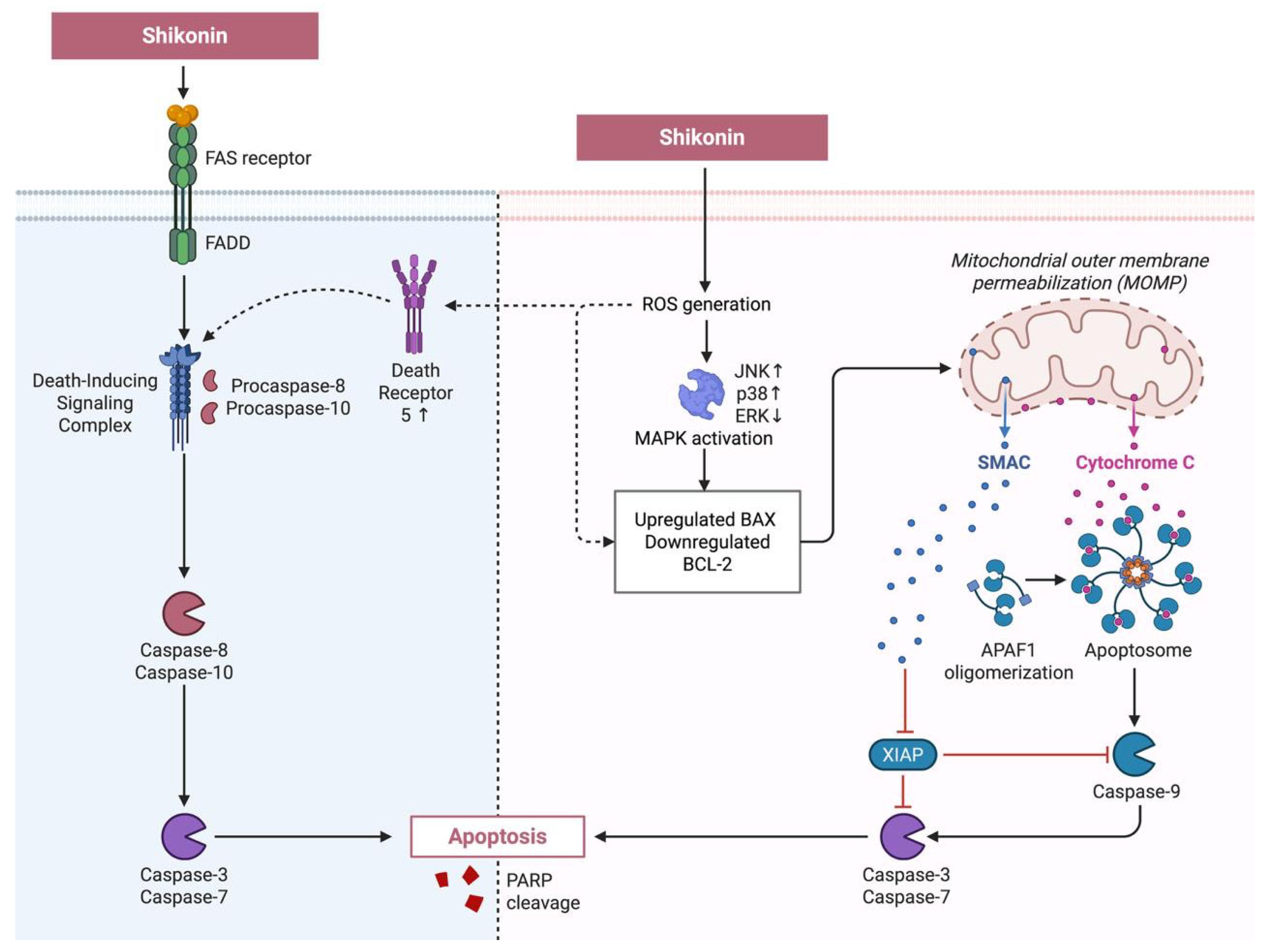
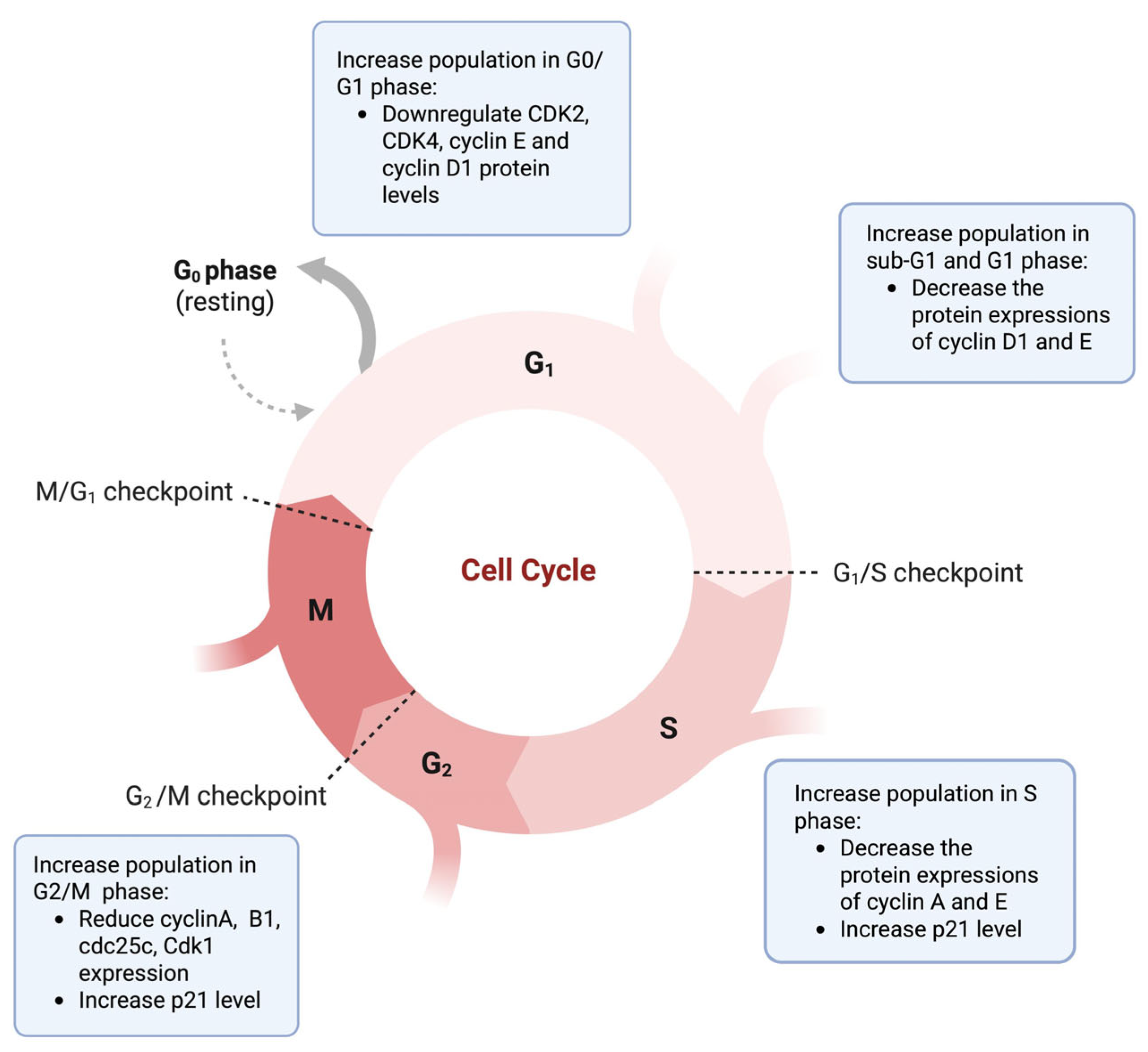
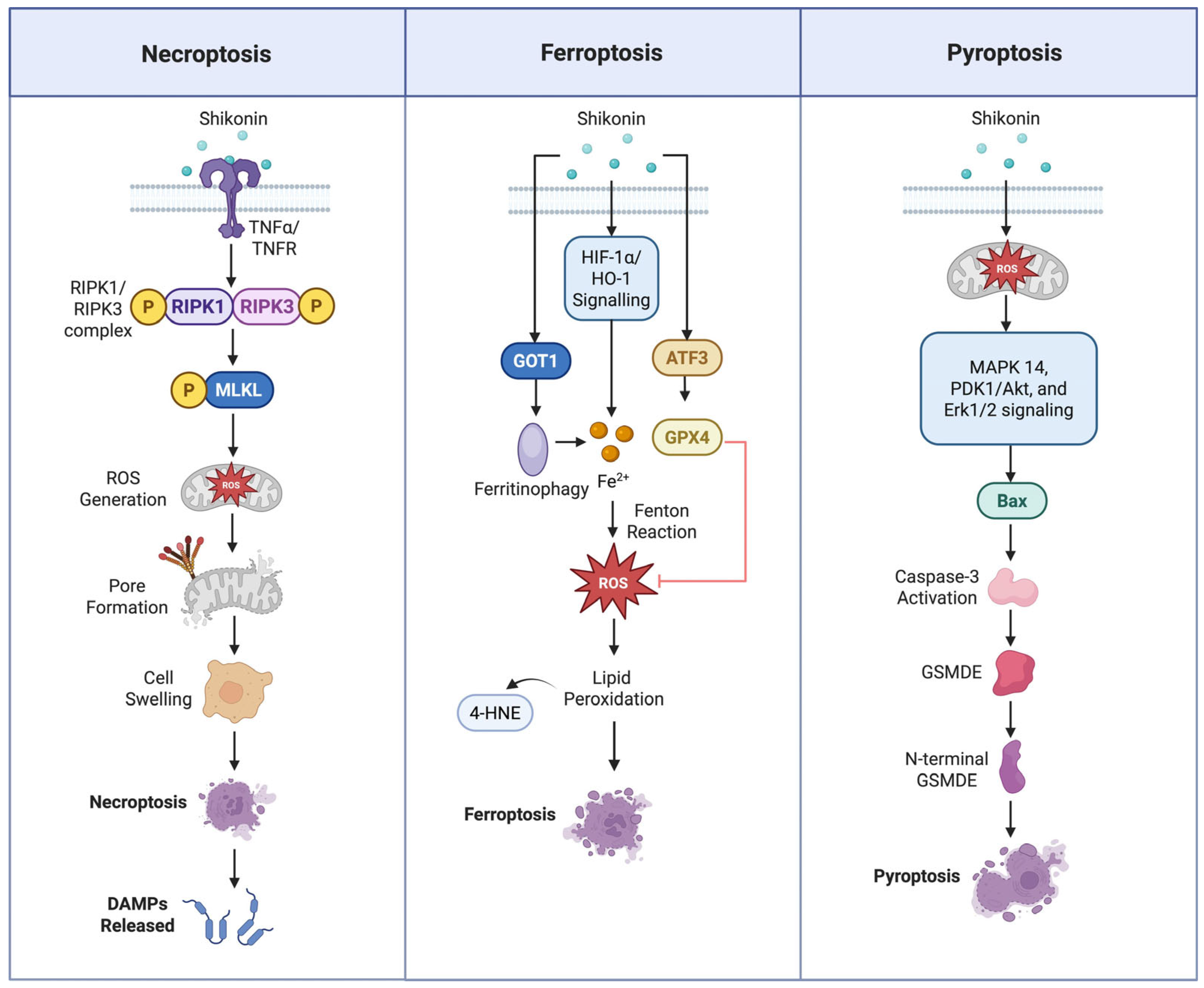
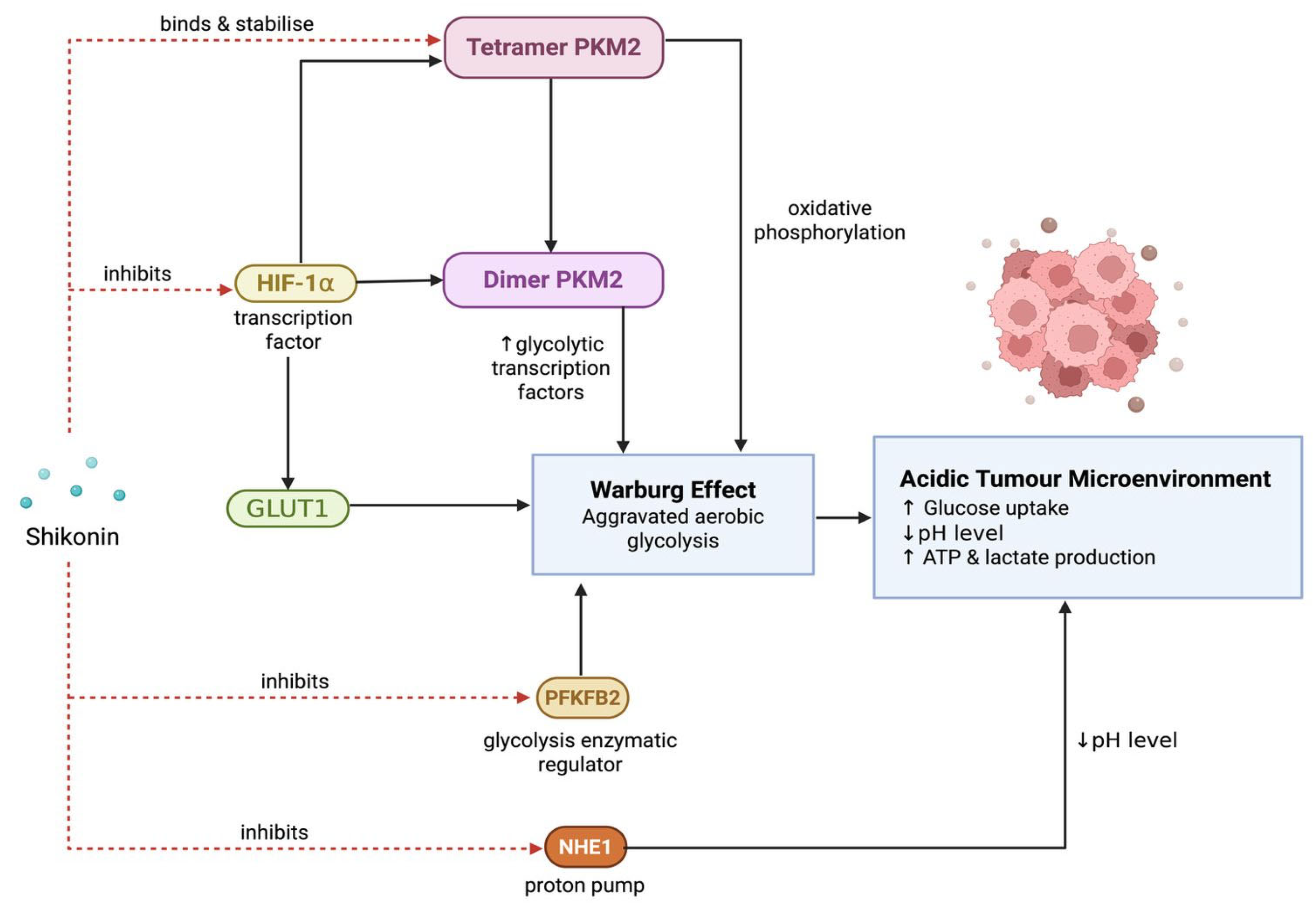
| Shikonin Derivatives | Chemical Structure | Structural Modifications | Cancer Types | Ref. |
|---|---|---|---|---|
| 5, 8-O-dimethyl acylshikonin | 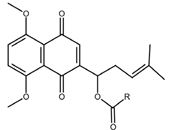 | Methylation of phenolic hydroxyl group | Colon cancer Leukaemia Breast cancer | [39] |
| Shikonin oxime derivative | 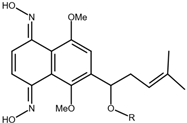 | Conversion of carbonyl to oxime group | Breast cancer Leukaemia Prostate cancer | [40] |
| α-methylbutyrylshikonin | 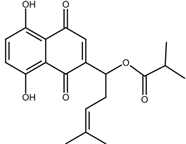 | Esterification of hydroxyl group with α-methylbutyryl group | Melanoma Leukaemia | [41,42] |
| β,-β-dimethylacrylshikonin | 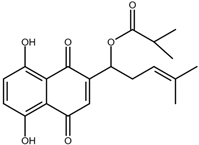 | Side chain esterified with dimethylacrylic group | Colorectal cancer Gastric cancer Medullary thyroid cancer | [43,44,45] |
| Acetylshikonin | 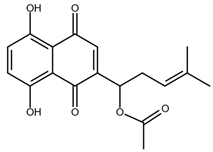 | Acetylation of hydroxyl group | Oral squamous cell carcinoma (OSCC) Non-small cell lung cancer (NSCLC) Colorectal cancer | [46,47,48,49] |
| β-hydroxyisovalerylshikonin | 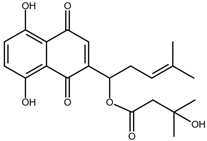 | Esterification with β-hydroxyisovaleryl group | Pancreatic cancer Cervical cancer | [49,50] |
| Deoxyshikonin | 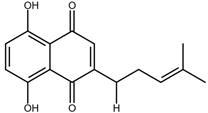 | Removal of hydroxyl group | Cervical cancer | [51] |
| Isobutyrylshikonin | 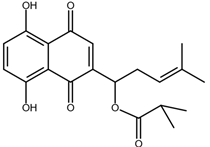 | Esterification with isobutyrl group | Oral cancer | [52] |
| Shikonin Derivatives | Target Cancer Types | Pathways | Results | Ref. |
|---|---|---|---|---|
| Acetylshikonin | Leukaemia (K562) | Intrinsic | ↑ Cleaved caspase-3; ↑ PARP; ↑ Caspase-9 | [101] |
| β-hydroxyisovaleryl-shikonin | Ovarian (HeLa) | PI3K/AKT/mTOR | ↓ PI3K; ↓ AKT; ↓ mTOR; ↓ P70S6K mRNA | [50] |
| Shikonin M12 | Colorectal | Intrinsic | ↑ ROS; ↓ MMP | [100] |
| β, β-Dimethylacrylshikonin | Colorectal (HCT-116) | Intrinsic | ↓ Bcl-2; ↑ Bax | [43] |
| Skin (BRAF/NRAS-mutated) | Intrinsic | ↑ NOXA; ↑ Caspase-3 activation | [102] | |
| Chordoma (MUG-Chor1, U-CH2) | Intrinsic | ↑ NOXA; ↑ PUMA | [103] | |
| Cyclopropyl-acetylshikonin | Skin (WM9, WM164) | Intrinsic | ↑ Caspase-3/7 | [98] |
| Acetylshikonin and cyclopropylshikonin | Chondrosarcoma (Cal 78, SW-1353) | Intrinsic | ↑ Caspase-7/9; ↑ NOXA; ↑ γH2AX | [68] |
| E2 | TNBC (MDA-MB-231) | PDK1/PDHC axis | ↑ ROS; ↑ Bax; ↑ Fas | [99] |
| Cancer Type | Combination | IC50 (μM) Reduction | Apoptosis (% Annexin V+) | Key Molecular Changes | Ref. |
|---|---|---|---|---|---|
| Lung (A549, PC9) | Shikonin + Cisplatin | A549 (5.74 µM); PC9 (6.30 µM) | A549 (+650%); PC9 (+525%) | ↓ PKM2; ↓ Glycolysis; ↓ Exosome | [141] |
| Ovary (A2780/DDP, SKOV3/DDP, OVCAR4/DDP) | Shikonin + Cisplatin | A2780/DDP (23.46 µM); SKOV3/DDP (50.06 µM); OVCAR4/DDP (18.06 µM) | Not reported | ↑ HMOX1; ↑ Heme breakdown; ↑ Fe2+; ↑ ROS; ↑ Lipid peroxidation; ↑ Ferroptosis | [147,149] |
| Oesophagus (KYSE-150, KYSE-270) | Shikonin + Paclitaxel | Not reported | KYSE270 (+ ~367%) | ↑ p53 activation; ↓ Bcl-2 expression | [154] |
| Pancreas (PANC-1, BxPC-3) | Shikonin + Gemcitabine | PANC-1 (1.800 μM); BxPC-3 (3.18 μM) | PANC-1 (3 μM—14.66%; 5 μM—83.35%; 10 μM—90.50%); BxPC-3: (3 μM—~7%; 5 μM—~14%; 10 μM—~17%) | ↓ PAK1; ↓ Downstream signalling; ↑ Apoptosis | [161] |
| Breast (MDA-MB-435, MCF-7) | Shikonin + 4-hydroxytamoxifen | Not reported | MDA-MB-435S (26.3%); MCF-7( 22.9%) | ↑ ROS; ↓ MMP; ↑ Apoptosis | [166] |
| Breast (MCF-7R) | Shikonin + Tamoxifen | Not reported | Not reported | ↑ lncRNA uc.57; ↓ BCL11A; ↓PI3K/AKT and MAPK pathways | [170] |
| Breast (MDA-MB-468) | Shikonin + anti-PD-1 | 3.59 μM | Z-VAD-FMK (~2%); Nec-1 (~39%) | ↑ RIP1K and RIP3K; ↑ ROS; ↓ MMP; Necroptosis | [177] |
| Colon (CT26) | Shikonin + anti-PD-1 | Not reported | 12.47% (5 μM); 20.17% (10 μM) | ↑ Calreticulin exposure; ↑ Hsp70; APCs activation | [181] |
| Colon (HCT116, LN428, H460, A549) | β, β-Dimethylacrylshikonin + IR | Not reported | ~200% | ↑ ROS; ↑ DNA damage; ↑ Apoptosis | [150] |
| Kidney (SKRC-17, RCC-53) | Shikonin + Ipilimumab | 1.32 μM | ~344% | ↓ FoxP3+ Tregs; ↑ Activation of CD8+ and CD4+ T cells | [185] |
| Cancer Type/Model | Agent | Mechanism of Action | Main Outcomes | Ref. |
|---|---|---|---|---|
| Melanoma (A375 xenograft, mice) | Shikonin (5.0 mg/kg) | ↑ Apoptotic proteins | Greater tumour suppression vs. dacarbazine | [111] |
| Melanoma (B16F10 lung metastasis, mice) | Shikonin + Quercetin | PKM2 inhibition, ↓ platelet–tumour interaction, ↓ glycolysis | Fewer metastatic nodules; no adverse effects | [186] |
| Breast cancer (Orthotopic; TNBC, MCF-7) | Shikonin | PDK1 inhibition, EMT suppression | ↓ Tumour invasion and growth; TNBC sensitivity | [17,187] |
| Breast cancer (MCF-7 xenograft, mice) | Shikonin + siRNA/TGF-β nanoparticle | ICD induction (calreticulin exposure), improved biodistribution | 21.8% ICD; tumour-specific targeting | [188] |
| HNSCC (xenograft, mice) | Shikonin | Suppression of FAM83A/PKM2 axis | ↓ PKM2 expression; ↓ tumour progression | [189] |
| Cervical and ovarian cancer (xenograft) | Shikonin | Apoptosis, anti-metastatic activity | ↓ Tumour growth; ↑ cisplatin sensitivity | [17,147] |
| Oral cancer (mouse model) | Shikonin | Apoptosis induction | Tumour growth inhibition | [190] |
| Pancreatic cancer (cell models) | β-hydroxyisovaleryl-shikonin | ↑ ROS, apoptosis | Enhanced cytotoxicity | [154] |
| Clinical trial (lung cancer, 1991) | Shikonin (dose unclear) | Not reported | >25% tumour reduction; mean survival ~10 months | [191] |
Disclaimer/Publisher’s Note: The statements, opinions and data contained in all publications are solely those of the individual author(s) and contributor(s) and not of MDPI and/or the editor(s). MDPI and/or the editor(s) disclaim responsibility for any injury to people or property resulting from any ideas, methods, instructions or products referred to in the content. |
© 2025 by the authors. Licensee MDPI, Basel, Switzerland. This article is an open access article distributed under the terms and conditions of the Creative Commons Attribution (CC BY) license (https://creativecommons.org/licenses/by/4.0/).
Share and Cite
Lew, C.-Y.; Tang, Y.-T.; Lee, A.Y.-J.; Chin, Z.-J.; Chang, W.-L.; Chen, C.-H.; Chye, S.-M. Shikonin as a Dietary Phytochemical with Multi-Target Anti-Cancer Activities: From Molecular Mechanisms to Translational Applications. Nutrients 2025, 17, 3085. https://doi.org/10.3390/nu17193085
Lew C-Y, Tang Y-T, Lee AY-J, Chin Z-J, Chang W-L, Chen C-H, Chye S-M. Shikonin as a Dietary Phytochemical with Multi-Target Anti-Cancer Activities: From Molecular Mechanisms to Translational Applications. Nutrients. 2025; 17(19):3085. https://doi.org/10.3390/nu17193085
Chicago/Turabian StyleLew, Chun-Yik, Yi-Teng Tang, Amanda Yee-Jing Lee, Zhi-Jian Chin, Wan-Ling Chang, Ching-Hsein Chen, and Soi-Moi Chye. 2025. "Shikonin as a Dietary Phytochemical with Multi-Target Anti-Cancer Activities: From Molecular Mechanisms to Translational Applications" Nutrients 17, no. 19: 3085. https://doi.org/10.3390/nu17193085
APA StyleLew, C.-Y., Tang, Y.-T., Lee, A. Y.-J., Chin, Z.-J., Chang, W.-L., Chen, C.-H., & Chye, S.-M. (2025). Shikonin as a Dietary Phytochemical with Multi-Target Anti-Cancer Activities: From Molecular Mechanisms to Translational Applications. Nutrients, 17(19), 3085. https://doi.org/10.3390/nu17193085







